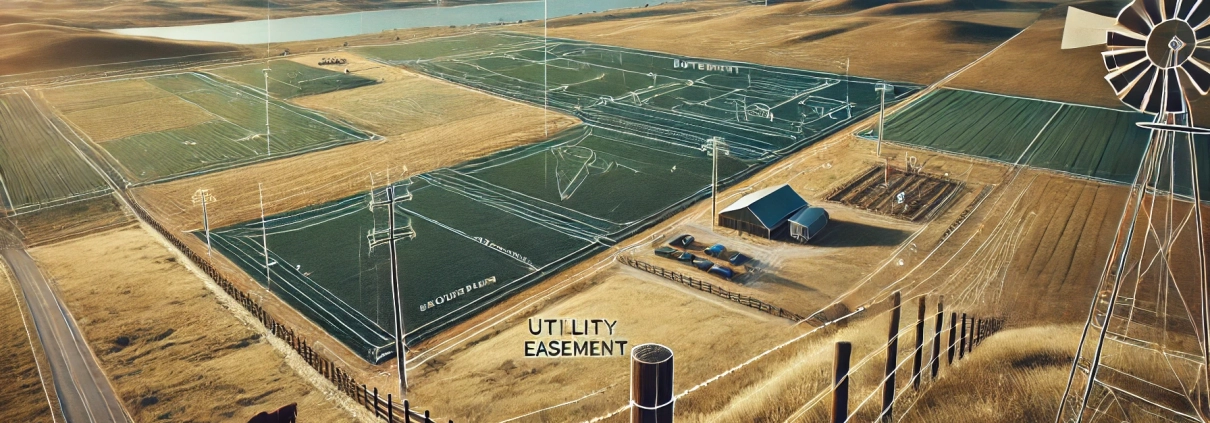Survey
A survey confirms crucial information about the location and existence of a property through boundary lines and a legal description. It will include information about physical improvements on the property, such as utility, parking, and building information, as well as details on access, property setbacks, encroachments, easements, or any other zoning violations that affect the property. Surveys will also indicate whether a property sits in a flood plain or other hazardous area. Common survey types include the following: as-built, boundary, and ALTA (American Land Title Association). An ALTA survey is the industry standard for most due diligence requirements.
Putting ‘Survey’ in Context
Heritage Harvest Partners, a family office focused on generational wealth-building, is in the process of acquiring Sage Creek Farms, a 1,200-acre parcel of farmland located in rural Idaho. The family office views farmland as a stable, long-term investment and plans to lease the land to local agricultural operators for crop production.
Before finalizing the purchase, Heritage Harvest Partners commissions an ALTA survey to ensure there are no unexpected issues that could affect the property’s value or usability. This survey provides a comprehensive view of the property’s boundaries, improvements, and any encumbrances that could impact future operations.
The survey reveals several critical details about Sage Creek Farms. First, it identifies an easement running along the eastern edge of the property, allowing a local utility company to access power lines. While this easement does not interfere with farming activities, it does restrict the use of this portion of the land for any permanent structures. The family office takes this into consideration when planning potential on-site storage or future construction.
Additionally, the survey uncovers a small encroachment near the southwest corner of the property where a neighboring landowner has extended a fence 10 feet over the property line. This discovery prompts Heritage Harvest Partners to negotiate with the neighbor to either remove the fence or establish a boundary agreement.
Finally, the survey identifies a portion of the northern acreage that lies within a 100-year floodplain. This detail is critical, as it affects potential crop selection and insurance costs. While the family office still moves forward with the acquisition, they adjust their financial model to account for potential flood risks in this area.
The survey serves as a vital due diligence tool, ensuring that Heritage Harvest Partners has a complete understanding of Sage Creek Farms before acquisition. Without the survey, they could have faced future conflicts with neighbors, utility companies, or unanticipated flooding issues, all of which could have impacted the financial performance of the investment.
Frequently Asked Questions about Property Surveys
What is the purpose of a property survey in real estate?
A property survey confirms boundary lines, legal descriptions, and physical features of a property. It identifies improvements, easements, encroachments, flood plains, and any zoning violations that could affect the property.
What is an ALTA survey and why is it important?
An ALTA (American Land Title Association) survey is a comprehensive survey used to satisfy due diligence standards in commercial real estate. It includes boundary lines, easements, encroachments, improvements, and zoning details.
How did the ALTA survey impact the Sage Creek Farms acquisition?
The survey identified a utility easement, a 10-foot encroaching fence, and a section within a 100-year floodplain. These findings influenced site planning, prompted neighbor negotiations, and led to adjustments in the financial model.
What are common issues revealed by surveys?
Surveys often reveal easements, encroachments, setbacks, zoning violations, floodplain exposure, and inaccurate boundary assumptions—any of which could affect development, value, or legal rights.
How can a survey help mitigate investment risk?
Surveys uncover legal and physical conditions that may not be visible during site visits. This helps investors like Heritage Harvest Partners avoid future disputes, ensure compliance, and plan around physical constraints.
What are the different types of surveys used in real estate?
Common types include boundary surveys (defining property lines), as-built surveys (documenting existing structures), and ALTA surveys (used in commercial due diligence to meet industry standards).
Click here to get this CRE Glossary in an eBook (PDF) format.

